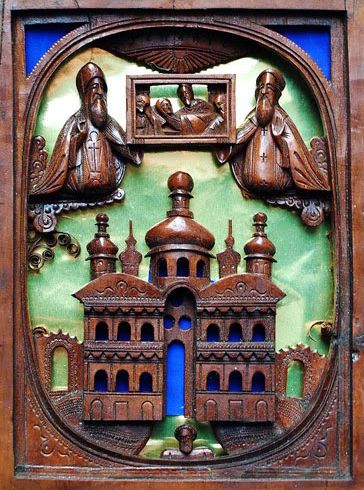Carved Orthodox sacred objects
Unique and ancient crosses and icons on display in Dnipropetrovsk
The exhibit “Carved Orthodox Sacred Objects in Collection of DNIM” [Dnipropetrovsk National Historical Museum] has been launched at Dmytro Yavornytsky Memorial House Museum. It represents religious objects from the collection of Dnipropetrovsk National Historical Museum, which was actively formed back in the time of directorship of academician Dmytro Yavornytsky. At the beginning of the 20th century he traveled a lot across the region, searching for church ancient objects.
Carved wooden icons and crosses, which were used in Ukraine and beyond it, are a unique part of the collection. Many of them were created mostly in the Kyiv Cave Monastery beginning from the 17th century. A lot of these items were preserved in the museum collection, and it is the first time they are exhibited separately. Apart from icons and crosses, the exhibit shows objects of religious use, ecclesiastical attire, and rare photos of Orthodox sacred objects of late 19th – early 20th centuries. The aim of the exposition is not only to display the unique objects from the religious collection of DNIM, but also to show craftwork of Kyiv Cave Monastery masters and tell the tourists about the symbolism of cross in Christian culture and evolution of church items in Orthodox art, as well as to remind of Dmytro Yavornytsky’s activity in collecting the religious objects of the museum.
“In 1905 a church department was created in our museum,” research fellow Viktor Yekshov says, “Its director Dmytro Yavornytsky got permission of the consistory to withdraw things which have considerable historic and cultural value. Yavornytsky succeeded in convincing the priests that museum is a temple as well, only a temple of culture.” The director of the museum did a lot to collect and preserve for descendants ancient objects from churches and monasteries located in the lands of Zaporizhian Army. The funds were filled also by donations of private persons, in particular, well-known Ukrainian collectors. Yavornytsky managed to preserve many religious objects in the time of Civil War and in Soviet time, when the churches were closed en masse. They say the academician managed to bring to administration of the oblast the idea of creation of an atheism museum at the Transfiguration Cathedral. In such a way he managed to save the ancient church and many church items from ruination.
The greatest attention of the visitors during the launch of the exhibit was drawn by icons and crosses – the ones worn close to the body, altar crosses, and the ones to be brought outside, decorated by masterful carving on wood, stone, and pearl. “In 17th-19th centuries many believers wanted to go on pilgrimage to Holy Land,” Yekshov says, “The journey was dangerous and long, it could last for two-three years, and pilgrims often lived in monasteries in Jerusalem, Bethlehem, or at Athos Mountain in Greece. Namely from there many decoration methods were brought to Ukraine, because believers bought cypress crosses and icons decorated with carving and incrustation as souvenirs. Later crafting traditions of Greece and Near East were picked up and developed by Kyiv Cave Monastery craftsmen. One can look at and study for a long time all objects decorated with subtle carving, because they are covered with biblical pictures and inscriptions.”
Pilgrims often gave or left by will these expensive relics to churches or monasteries. The collection includes altar crosses with gift inscription of wealthy donors. Interestingly, Yavornytsky collected these church relics not only in Katerynovslav gubernia, but in other regions as well, like in Galicia or Transcarpathia, therefore the collection represents the artistic traditions of entire Ukraine.
Apart from carved objects, the exposition includes ecclesiastical attire and church embroidery, as well as ancient photos, which depict people from the previous time and items that were destroyed during the war. The religious collection of the museum includes such unique items as a Kyivan Rus’ cross worn close to body, which was found by archeologists. The museum employees say this is the oldest item, which was one of the rarities in the great collection of entrepreneur and patron Oleksandr Pol.






